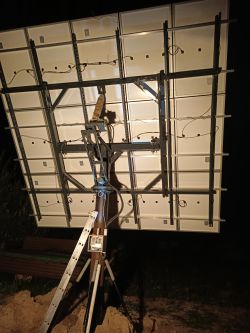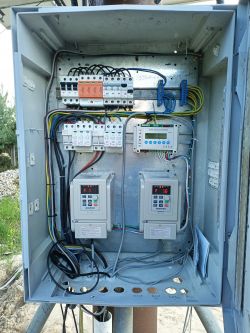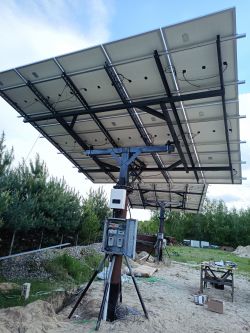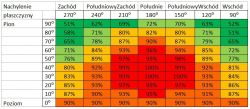bachin wrote: marik_te wrote: Let me insert a photo of a design I had the pleasure of creating some time ago.
Two tables on separate trackers with 15 340W panels each.

Can I get more data:
-dimensions,
-bearings,
-drives, etc.?
I'm planning to make something similar from scrap metal, because cost is important.
Unfortunately, I can't say much, because as soon as I did the electrical part.
Each tracker, and there were two is for 15 panels, 5 each in 3 rows. Which, with 340W panels, gives some 5mx5m table dimensions. The turntable was at a height of about 3m from the ground, which made it possible to mount the table inclined in the middle and maintain a safe distance from the ground even when vertically inclined. The drives came from disassembly ( some obtained from the dismantled tonsil factory), they were drives on a double reducer with a motor of about 50-100W three-phase. The slewing reducer directly drove the slewing through a permanently mounted pinion at the bottom of the base. I know it would have been simpler if it had been the motor at the bottom and the pinion rotated with the top; but that was not my idea. The inclination was made based on a threaded rod put through something like a nut directly in the reducer. This gave the possibility to adjust the tilt from horizontal to vertical.
On the electronic side, a solar tracker controller of the Reivision project rebuilt by the manufacturer to work with the inverter was used. The control was a simple "0" to one input ran the motor one way, and a "0" given to the other input of the inverter ran the motor the other way. The controller had a light probe connected to it, which resembled 4 small panels of about 1x2cm arranged in a square and at an angle of about 80 degrees to the table. It worked by comparing the voltages from these 4 panels and sought to drive the motors in such a way as to get the same voltage from the detectors.
From what I know the installation has been in operation for approx. 2 years and, with the exception of a problem with one of the controllers, where it was damaged, most likely by a discharge, everything works flawlessly. The yields are more than two times higher compared to a similar installation installed stationary.


[video:01e0805fc2]https://filmy.elektroda.pl/53_1699736786.mp4[/film:01e0805fc2].


.


 [video:01e0805fc2]https://filmy.elektroda.pl/53_1699736786.mp4[/film:01e0805fc2].
[video:01e0805fc2]https://filmy.elektroda.pl/53_1699736786.mp4[/film:01e0805fc2].